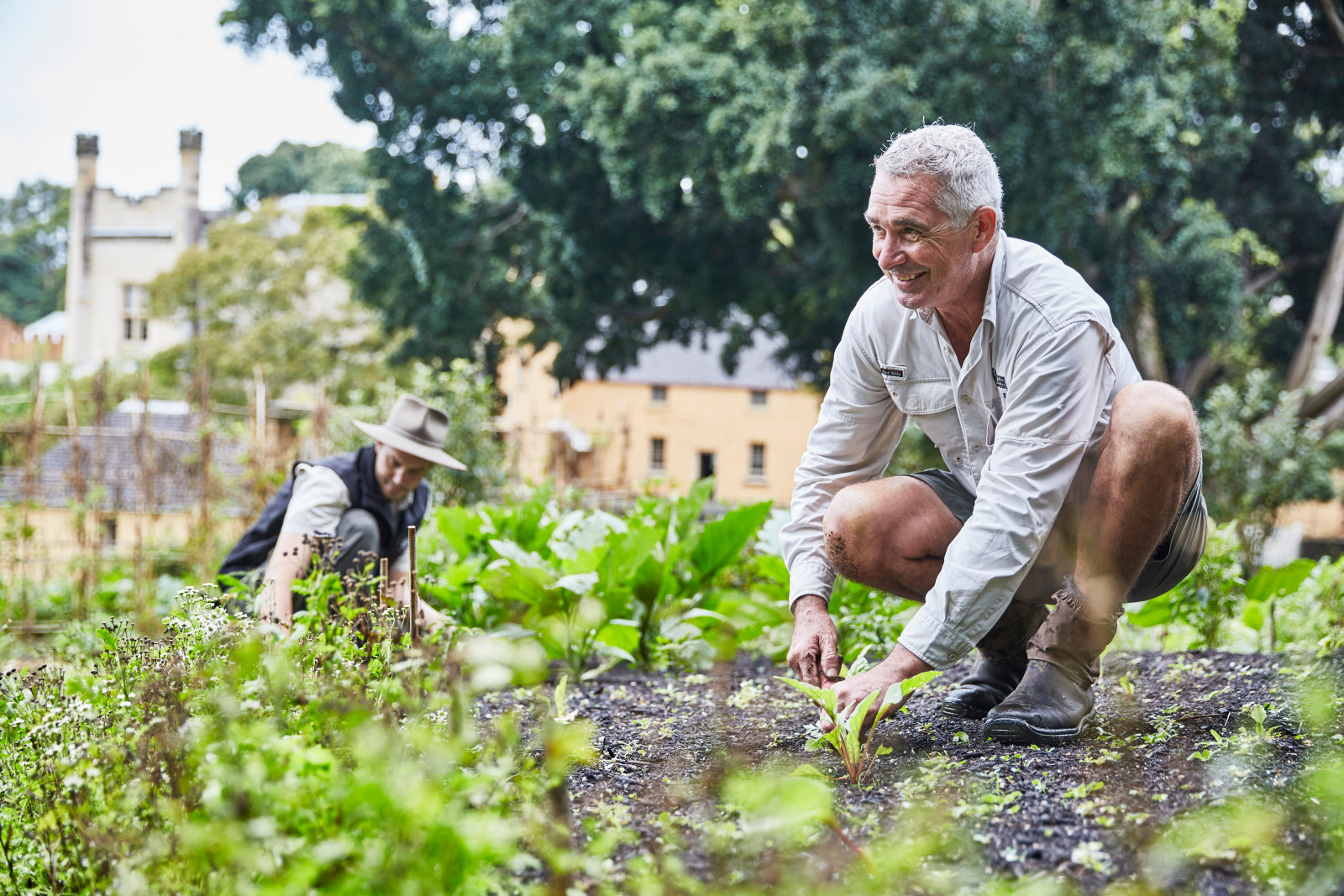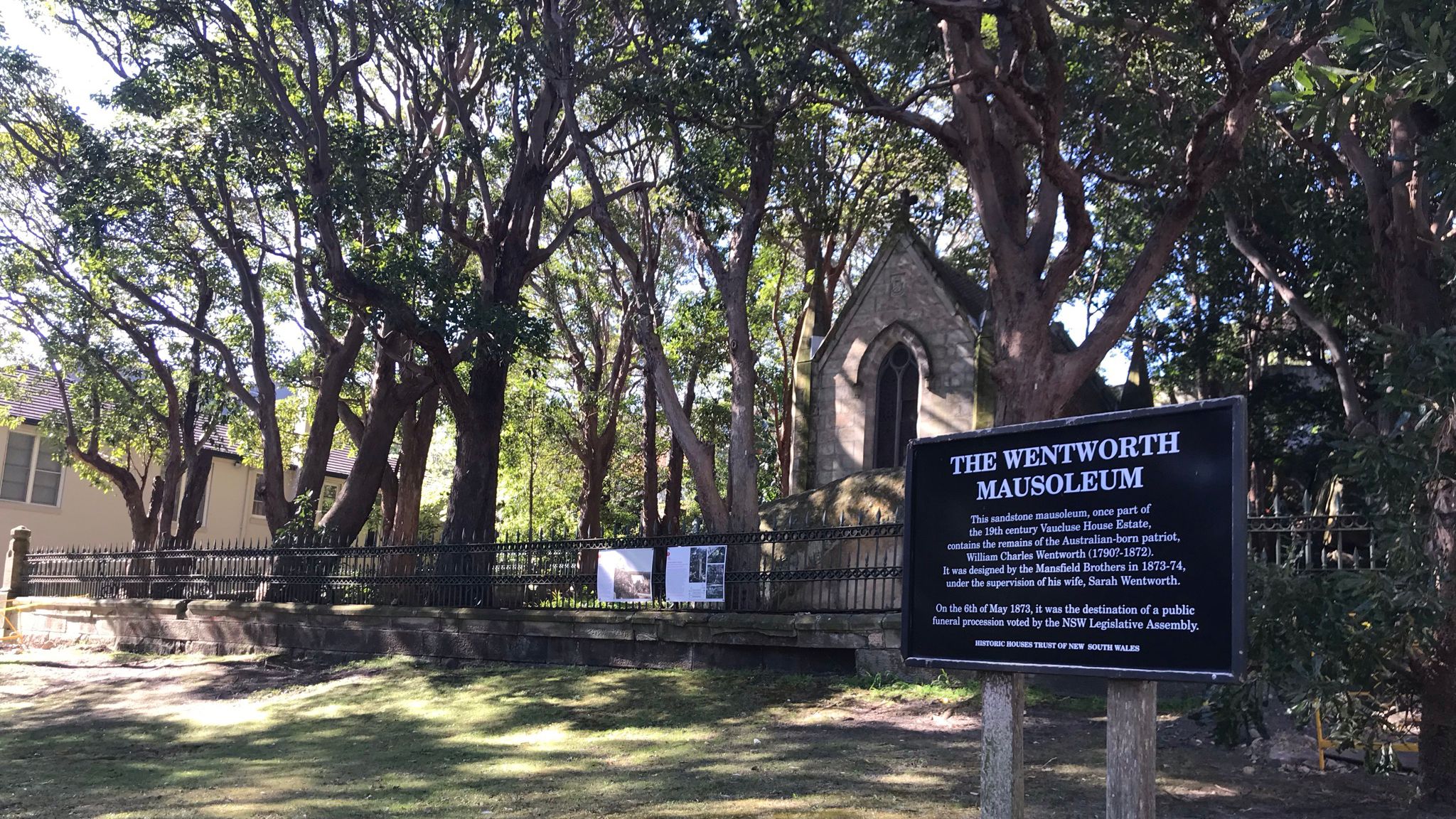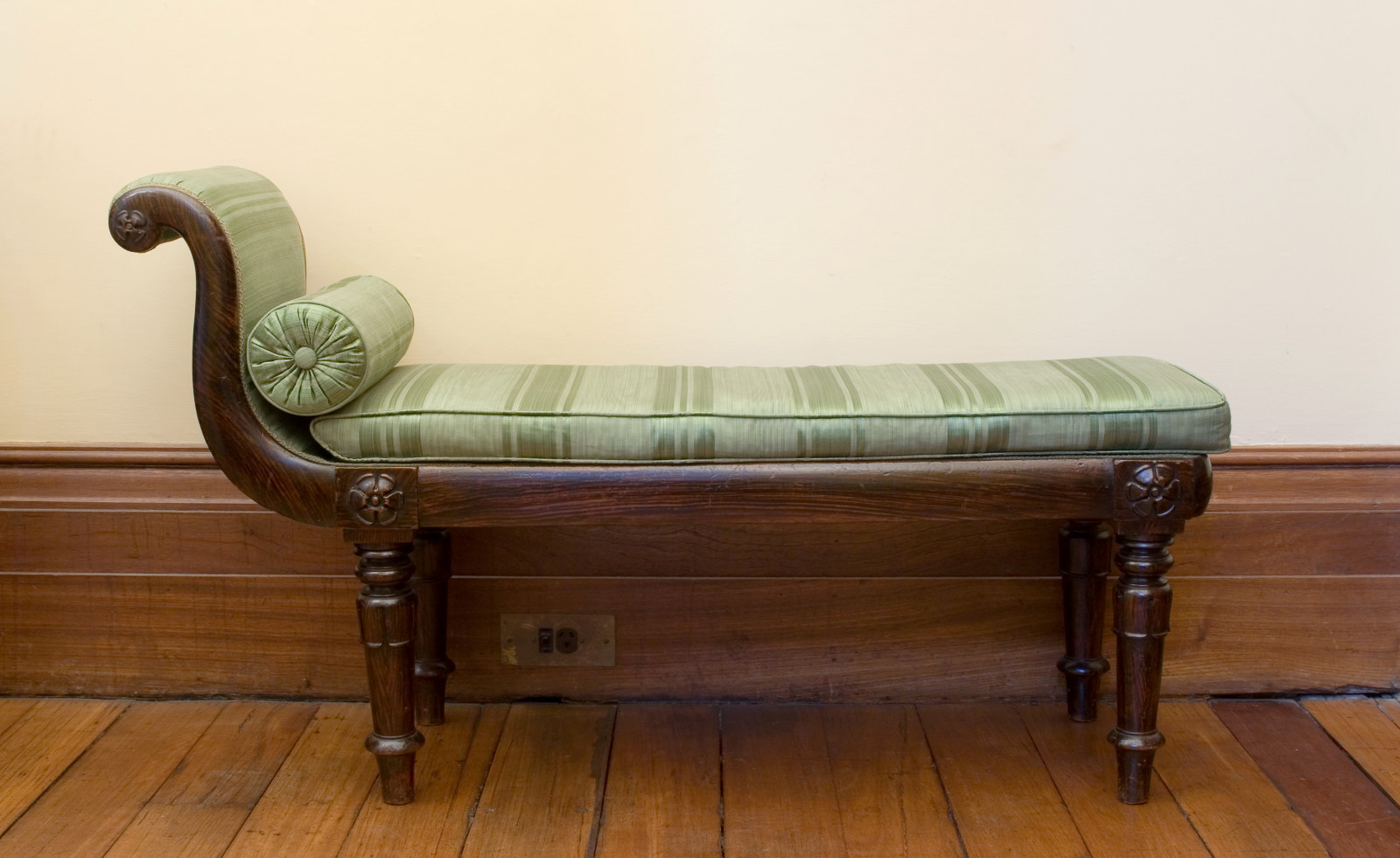Vaucluse House: a centenary
A century after the honorary board of trustees voted to form Vaucluse House as a museum, we celebrate their vision and pay tribute to the role Sydney Living Museums (now Museums of History NSW) has played in preservation, conservation and interpretation.
In 2015 we celebrate the centenary of the first step towards the creation of Vaucluse House as a museum. Today the house is well known as a house museum, the former home of statesman and patriot William Charles Wentworth (1790–1872), his wife, Sarah, and their ten children. It was not always so.
The Wentworth family lived in the house from 1827 to 1853 and from 1861 to 1862, spending the intervening years in England for the children’s education. William died in England in 1872. As he had wished, his body was brought back to Sydney and, following a state funeral on 6 May 1873, William was laid to rest in a vault excavated from rock on the Vaucluse estate. A chapel was eventually erected over the tomb. Sarah died in England in 1880. The house remained in Wentworth family ownership, with periodic family occupation, until the house and 22.9 acres (9.2 ha) of land was resumed for recreational purposes by the NSW Government. An honorary board of trustees was appointed to manage the property. In the meantime most of the original Vaucluse estate had been subdivided and sold when the contents of the house were put to auction in 1900.
Five years into public ownership the trustees voted to appoint a subcommittee ‘to take steps to form a museum for Australian Historical records and objects at Vaucluse House.’1
Between 1910 and 1915 many purposes for the site had been suggested – and rejected. Some suggestions were a kindergarten, a museum celebrating the work of the artist Ellis Rowan and even a country club complete with artificial lake. After the outbreak of World War I some new proposals were floated: firstly for a convalescent hospital and, later, a war museum. There were also more general requests to use the site, including for making moving pictures (silent cinema), cricket matches, Sunday school visits, moonlight fetes hosted by the Vaucluse branch of the Red Cross, even for the agistment of livestock.
As a curator today reading the Vaucluse Trust minute books from these early years, much is familiar. The trustees grappled with mundane but essential operational issues similar to those that face SLM today. They discussed signage, paths, fencing, the purchase of garden tools, park seating, the erection of notice boards, selling light refreshments on the verandah and the need for ‘additional sanitary accommodation’.2
One issue from that time that is no longer a concern is the matter of bathing. In late 1911 the possibility of public bathing in Vaucluse Bay troubled the trustees so much that they resolved ‘no person shall disrobe upon or traverse any portion of the Park unclad or in bathing costume’.3
Towards a museum
The development of Vaucluse House as a museum was incremental. The property had been proclaimed as Vaucluse Park in 1911. The following year the unfurnished ground floor of the almost dilapidated and largely empty house was opened to the public.
It was then known simply as the ‘Old House’. In 1913 the trustees began research into the property by contacting the principal of the Mitchell Library. They were ‘… desirous of obtaining as far as possible information with regard to the age of the old house and its associations as regards the occupation by the late William Charles Wentworth.’ 4
‘Wentworth house’ and wisteria days
In 1921 the trustees made a concerted effort to establish parameters, if not a policy, in their approach both towards growing the museum’s collection and managing the site. In August that year they voted to raise £25,000 for the restoration of Vaucluse House and putting it in good order, refurnishing it with original period furniture, establishing a ‘Historical Museum (Wentworth period)’, constructing an ‘amphitheatre in the back portion of the Park (on the lines of the Grecian Theatres)’ and ‘improving the grounds with relics & monuments connecting Australian History and Ideals’.9
The trustees bought several pieces of Wentworth-provenanced furniture during the 1920s and in 1921 visitors were given access to the upper floors for the first time. Prior to this the house had been presented to the public with very little furniture or museum infrastructure. The trustees’ approach to room presentation was not based on historical evidence about room function, nor was it informed by an understanding of how the Wentworth family had actually lived in and used the house.
The trustees’ approach to management of the site in this early period was a combination of two ideas: the notion of the estate as a recreational park and the notion of the house as the home of a great Australian statesman. Many thousands of visitors were attracted to the property each spring when the wisteria was in full bloom, swathing the verandahs in swags of luxuriant mauve. From 1918 onwards the wisteria season led to an annual celebration of William’s birthday and the house acquired a new informal name, Wentworth House.
The trustees operated without the framework of heritage values and significance that we’re familiar with today. They made decisions that we’d now regard as an arbitrary rewriting of the past, making dramatic alterations to the historic fabric of the property, embellishing here, demolishing there. The most interventionist of these changes was the 1917 addition of crenellations and corner turrets to the eastern end of the facade of the house. The trustees set about ‘completing’ the house as they imagined William had intended before the economic depression that hit NSW in the early 1840s forced him to abandon his building plans. In 1916 the trustees demolished what would today be considered a very significant timber bedroom skillion at the rear of the house and, later, removed a ruinous but romantic structure known as the ‘convict barracks’ that sat on a rise above the stables.
By 1915 the trustees were intent on promoting the site as a museum of Australian history. Funds raised through a donation box were to be used for obtaining and preserving historical records and relics, with the dining room set aside to store such items. At the same time the trustees were clearly interested in the Wentworth family, particularly in William Charles Wentworth. In May 1915 they invited Mr Fitzwilliam Wentworth, son of William and Sarah, to sign the visitors’ book – which he did – and to ask him whether he had in his possession any paintings or ‘souvenirs’ belonging to his late father that he ‘might be disposed to return to the custody of the trustees to be preserved for the nation’5. The trustees’ ambitions were to replace as far as possible the original furniture and effects, to restore the house, to make it a museum about Australian historical subjects and to keep the house in good order as a tribute to the memory of William Charles Wentworth.6
They also decided that one of the rooms on the ground floor would in future be referred to as the ‘Constitution Room’, in celebration of Wentworth’s role in the development of the 1853 Constitution Bill, which in 1855 provided the first stage of full responsible government for NSW. In August 1915 the trustees contacted James R Lawson, the auctioneer who had disposed of the contents of Vaucluse House in February 1900, in an effort to determine the whereabouts of furniture from the library, the room they assumed to have been used by Wentworth when drafting the Constitution. The auctioneer regretted that he was ‘unable to trace the sale books’.7
As it happened, the earliest Wentworth-provenanced acquisition made by the trustees was a purchase close to home. It came from the property’s caretaker, Mr Henry Palmer. If a tiny pencil scrawl on the inside cover of the first minute book is to be believed, Palmer was ‘taken over’ along with the house when the property had been resumed. In September 1915 the trustees accepted an offer of sale from Mr Palmer for:
‘4 tables, 2 dressers, 1 large safe, 1 old clock, 1 pair steps, old mangle and ironing table, part of the original furnishings of Vaucluse House for the sum of £5’.8
Of these objects, the two dressers (pictured here) and the food safe remain in the house today and are central to the understanding and interpretation of the kitchen.
A new approach to place‑based interpretation
In 1978 the NSW Government transferred responsibility for the house and grounds to the state’s National Parks and Wildlife Service, retaining the trustees’ committee. In 1980 a new statutory authority – the Historic Houses Trust of NSW (HHT) – was established to conserve and manage historic houses in government ownership. The HHT (previously Sydney Living Museums) assumed responsibility for Vaucluse House in 1981.
Sydney Living Museums has taken a very different approach to interpreting the house and its collection, garden and grounds. We still place great emphasis on acquiring collection items previously owned by the Wentworth family and believed to have been at Vaucluse House between 1827 and 1910, particularly during the periods 1827–53 and 1861–62, but we also take a more authentic approach to the way the rooms are interpreted, conserved and furnished. Unlike the first decades of Vaucluse House as a museum, where the interiors ‘reflected the genteel tastes of its Board of Trustees and their spouses, with a predilection for Georgian chandeliers, oriental rugs and Adamesque wallpaper’,10 our approach is to make informed decisions about the spaces based on physical evidence, and documentary and pictorial sources. Our interpretation is place‑based, driven by authenticity and the desire for an immersive and vibrantly historic experience for visitors.
Notes
- Vaucluse Park Trust: Minute Book no 1, record of meeting held 20 August 1915.
- Vaucluse Park Trust, record of meeting held 3 March 1912.
- Vaucluse Park Trust, record of meeting held 7 December 1911.
- Vaucluse Park Trust, record of meeting held 20 February 1913.
- Vaucluse Park Trust, record of meeting held 28 May 1915.
- Vaucluse Park Trust, record of meeting held 28 May 1915.
- Vaucluse Park Trust, record of meeting held 24 September 1915.
- Vaucluse Park Trust, record of meeting held 24 September 1915.
- Vaucluse Park Trust, record of meeting held 26 August 1921.
- Ann Toy, ‘At Last – A New Philosophy For Historic Homes’, Vive la Vie, Connoisseur Publishing, Victoria, 1987, p100.
Published on
Related

The coolest room in the house
What practical techniques can we learn from historical building design to minimise heat and energy consumption in our homes today?

Conservation
Vaucluse House kitchen garden
The Vaucluse House kitchen garden recently underwent a significant rejuvenation project to preserve the site and allow it to continue to be used as a valuable educational resource

Wentworth Mausoleum perimeter fence conservation
MHNSW is undertaking the first comprehensive conservation works to the fence surrounding the 1870s resting place of William Charles Wentworth

Designed with intent: colonial vs modernist chairs
This selection of furniture juxtaposes the old with the new: early 19th-century colonial seating and modernist styles made over a hundred years later